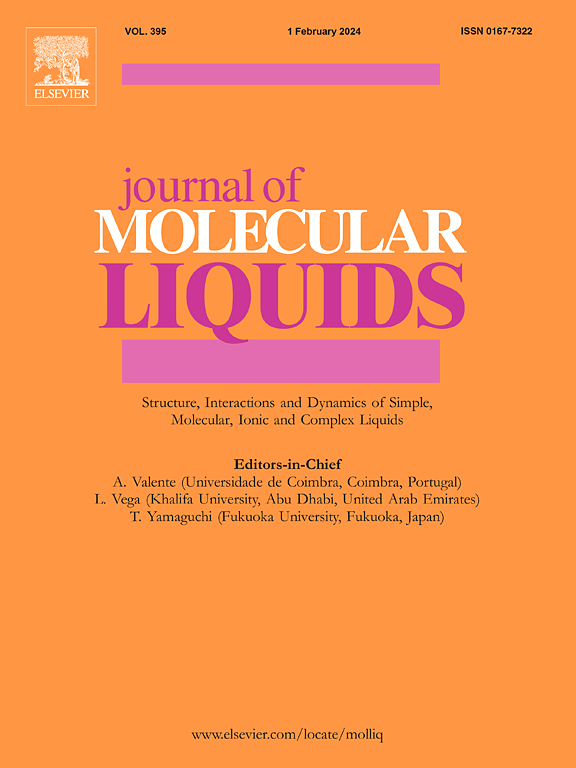A new semi-empirical correlation for the evaluation of the dynamic viscosity of nanofluids
IF 5.3
2区 化学
Q2 CHEMISTRY, PHYSICAL
引用次数: 0
Abstract
Thanks to their excellent heat transfer coefficient, nanofluids can be considered as ideal heat transfer fluids for a large number of relevant engineering and scientific applications. Precise assessments of their thermophysical properties are thus essential for reliable calculations. In this work, a new semi-empirical scaled correlation based on 8 parameters (volume fraction, temperature, base fluid critical temperature, base fluid density, base fluid critical density, nanoparticle diameter, base fluid molar mass, nanoparticle density) is introduced to evaluate the dynamic viscosity of nanofluids. The correlation is regressed and evaluated using a dynamic viscosity dataset for 32 nanofluids, including a total of 737 experimental points: 10 nanofluids have water as base fluid (Ag, Al2O3, Al2O3/CuO, C, CuO, diamond, Fe/Si, MWCNT, ND-Ni, TiO2), 6 nanofluids have ethylene glycol (Ag, Al2O3, CeO2, Co3O4, SiC, TiO2/CuO), 11 nanofluids comprise different mixtures of water and ethylene glycol (Al2O3, MWCNT/WO3, CB, fGnP, G/Dp, G/Dr, nD87, nD97, TiO2), 1 nanofluid has propylene glycol (SiC) and 4 nanofluids comprise different mixtures of water and propylene glycol (TiB2, TiB2/B4C, fGnP). The dynamic viscosity dataset was derived from experimental measurements documented in the scientific literature and conducted with samples that were prepared using consistent and reliable methods. The study evaluates the dynamic viscosity of nanofluids using 14 literature equations to verify their accuracy against the proposed correlation. Results show that the correlation has an average absolute relative deviation of 8.16%, which is significantly lower than that of the literature equations. A 4-fold cross-validation also shows that the correlation is resilient and accurate with different regression datasets.
用于评估纳米流体动态粘度的新半经验相关性
由于具有出色的传热系数,纳米流体可被视为大量相关工程和科学应用的理想传热流体。因此,对其热物理性质的精确评估对于可靠的计算至关重要。在这项工作中,引入了一种基于 8 个参数(体积分数、温度、基流体临界温度、基流体密度、基流体临界密度、纳米粒子直径、基流体摩尔质量、纳米粒子密度)的新的半经验比例相关性,用于评估纳米流体的动态粘度。使用 32 种纳米流体的动态粘度数据集(包括总共 737 个实验点)对相关性进行了回归和评估:10 种纳米流体以水为基液(Ag, Al2O3, Al2O3/CuO, C, CuO, diamond, Fe/Si, MWCNT, ND-Ni, TiO2),6 种纳米流体以乙二醇为基液(Ag, Al2O3, CeO2, Co3O4, SiC, TiO2/CuO),11 种纳米流体由水和乙二醇的不同混合物组成(Al2O3、MWCNT/WO3、CB、fGnP、G/Dp、G/Dr、nD87、nD97、TiO2),1 种纳米流体含有丙二醇(SiC),4 种纳米流体含有水和丙二醇的不同混合物(TiB2、TiB2/B4C、fGnP)。动态粘度数据集来自科学文献中记载的实验测量结果,并使用一致可靠的方法制备样品。研究使用 14 个文献方程对纳米流体的动态粘度进行了评估,以根据所提出的相关性验证其准确性。结果表明,相关性的平均绝对相对偏差为 8.16%,明显低于文献方程。4 倍交叉验证也表明,在不同的回归数据集上,相关性具有弹性和准确性。
本文章由计算机程序翻译,如有差异,请以英文原文为准。
求助全文
约1分钟内获得全文
求助全文
来源期刊

Journal of Molecular Liquids
化学-物理:原子、分子和化学物理
CiteScore
10.30
自引率
16.70%
发文量
2597
审稿时长
78 days
期刊介绍:
The journal includes papers in the following areas:
– Simple organic liquids and mixtures
– Ionic liquids
– Surfactant solutions (including micelles and vesicles) and liquid interfaces
– Colloidal solutions and nanoparticles
– Thermotropic and lyotropic liquid crystals
– Ferrofluids
– Water, aqueous solutions and other hydrogen-bonded liquids
– Lubricants, polymer solutions and melts
– Molten metals and salts
– Phase transitions and critical phenomena in liquids and confined fluids
– Self assembly in complex liquids.– Biomolecules in solution
The emphasis is on the molecular (or microscopic) understanding of particular liquids or liquid systems, especially concerning structure, dynamics and intermolecular forces. The experimental techniques used may include:
– Conventional spectroscopy (mid-IR and far-IR, Raman, NMR, etc.)
– Non-linear optics and time resolved spectroscopy (psec, fsec, asec, ISRS, etc.)
– Light scattering (Rayleigh, Brillouin, PCS, etc.)
– Dielectric relaxation
– X-ray and neutron scattering and diffraction.
Experimental studies, computer simulations (MD or MC) and analytical theory will be considered for publication; papers just reporting experimental results that do not contribute to the understanding of the fundamentals of molecular and ionic liquids will not be accepted. Only papers of a non-routine nature and advancing the field will be considered for publication.
 求助内容:
求助内容: 应助结果提醒方式:
应助结果提醒方式:


